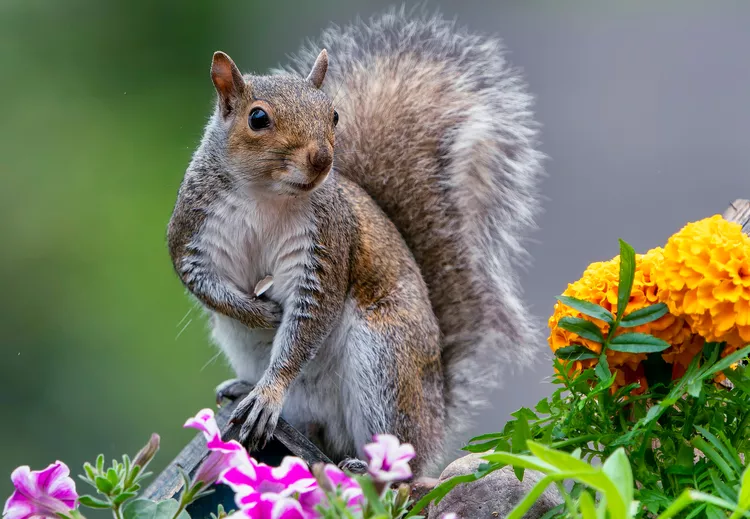While their antics are entertaining, squirrels can cause a lot of damage when they start digging up potted plants. Common tree squirrels with their big bushy tails and striped ground squirrels (also known as chipmunks) can uproot a thriving container garden in short order. Guided by their instinct to bury food for later use, squirrels often see a pot as a perfect spot for hiding their bounty. Also, the tender vegetation in the container is a tempting food source. Encourage these active rodents to play in the dirt elsewhere with these simple tactics for protecting your potted plants.
1. Make a Barrier
Disrupt a squirrel’s container feast or digging habit with the help of a barrier. While barriers are rarely effective in a traditional garden setting—tree squirrels and ground squirrels can easily circumvent the most advanced barriers erected in large spaces—they can be useful in a container garden.
You can create a simple DIY barrier with a cylinder of chicken wire or fine mesh just inside the lip of the container. Extend the cylinder at least 2 feet above the rim of the pot. Mold the wire to the shape of the container as needed.
Leave the barrier in place for at least two weeks to interrupt the squirrel’s habit. With some time and a little luck, the critter will find a new food source, create a new habit, and abandon your container garden.
2. Use Rocks as Mulch
Both ground squirrels and trees squirrels are often more interested in what is under the soil than the plants growing in the soil—although they will snack on tender container plants if food sources are scare. Thwart them from making a mess out of your pots by spreading a layer of 2-inch river rock over the soil surface around your plants. The effort of pushing aside the rocks may encourage the rodents to scamper off to a more agreeable digging site.
3. Apply Repellents
A host of commercial rodent repellents are on the market. How well a particular product deters marauding tree squirrels and ground squirrels from your containers depends on the preferences of the animals in your yard. When trying a product, you'll need to reapply it after each rain for at least a couple of weeks or until there's no more digging happening in your treated pots. If it isn’t effective, try a different product.
4. Interrupt Squirrels' Habits
Squirrels are creatures of habit. When they find a food source they love, they return to it repeatedly. If possible, try moving a squirrel's favorite container for digging elsewhere. Simply moving the container from the known location can reset a squirrel's feeding and digging patterns.
For example, park your pots in a well lit shed (sun-loving container plants will be just fine near a bright window for a few days) or closer to higher traffic areas like your porch or deck. Return your container garden to its original location after 5 to 7 days. Or if the new spot is suitable for the plants, keep the pot where it is if squirrels tend to leave it alone there.
5. Move Up
Squirrels are less likely to raid hanging baskets and window boxes simply due to the extra work involved in accessing them. If squirrels are relentless in your area, consider moving your prized plants into hanging containers. All kinds of flowering annuals bloom with gusto in hanging pots. You can even grow tomatoes up high. For example, 'Tumbling Tom' cascades over the edge of a pot, producing easy-to-pick sweet cherry tomatoes.
6. Use Multiple Methods
If one squirrel prevention tactic works for a while and then becomes ineffective, try a new method. Barriers are generally the best at keeping squirrels out of pots, but not always the most aesthetic choice. Repellents can also have good success but require diligent applications. Scare devices and ultrasound technology are generally less effective methods, but could be worth trying to see how they work on your resident squirrels.
7. Don’t Feed the Squirrels
One method not endorsed by wildlife researchers is attempting to distract squirrels from containers by providing food for them in an out-of-the-way area of the landscape. "Feeding squirrels is not advised as it simply increases the population density in your area," says Dr. Dennis Ferarro, professor of Conversation Biology at the University of Nebraska. Instead, outsmart squirrels by switching up the above tactics as needed to at least reduce the amount of digging squirrels will do among your potting plants.




















